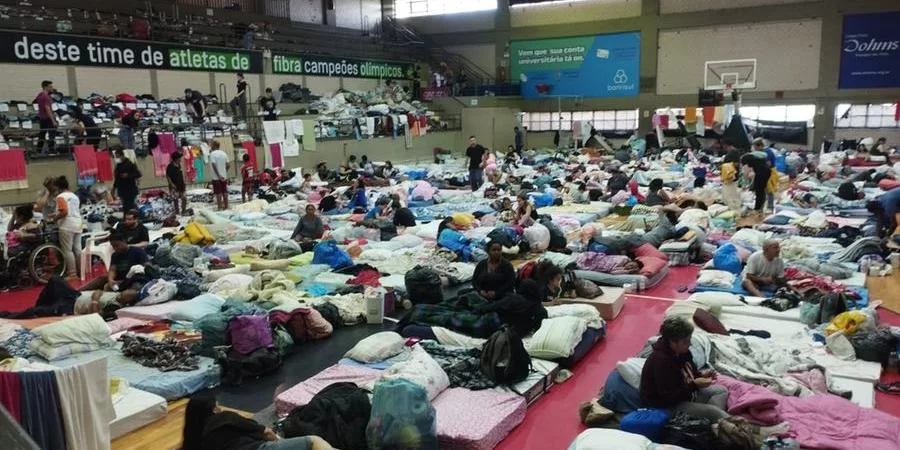Rio Grande do Sul is experiencing its most extensive extreme weather event. The state of calamity has lasted four weeks and is far from over, challenging the limits of human endurance. Warnings about the increasing frequency and severity of climate phenomena are not new, but to what extent do we understand the devastating implications they can have on our lives? Directors Ana Rosa and Ivi Pauli have been reflecting on this topic and invite you to a crucial debate on systemic action to promote resilience and adaptation in the face of this new reality in so many places.
Authors: Ana Rosa & Ivi Pauli
Leia em Português
Facing climate change is no longer a choice
Irrefutable scientific evidence underscores the urgency of addressing climate change. Today, even in the most optimistic scenario where the promises of major agreements are fulfilled, simulations indicate that global warming could approach 2°C. This is still dangerous, as it could destabilize critical points in climate systems, the tipping points, leading to irreversible changes in the global climate. Recent events suggest that prevention may be slipping out of our reach, and we must prepare to adapt to and mitigate extreme climate events.
“The climate chaos seemed something still distant, and I couldn’t grasp, until now, the proximity or the proportions of the impact of our actions or the depth of their systemic structures.”
Ana Rosa, Meli’s Director.
Extreme weather events in Brazil
In Brazil, extreme weather events have become more frequent in various regions in recent years. From the historic drought in the Amazon to heatwaves in the Midwest and Southeast, and severe recurring rains and floods in Rio Grande do Sul, we are confronted with clear evidence of the impacts of these extreme events in our daily lives. Ana Rosa, founder of Meli, mentions something very common to many of us: “In 2018, I was already interviewing climate change experts for the podcast that laid the groundwork for the start of Meli. Still, the climate chaos seemed something distant, and I couldn’t comprehend, until now, the proximity nor the proportions of the impact of our actions or the depth of their systemic structures.“
Experiencing the changes firsthand
In late 2023, Ana visited the Amazon to see her family and the activities of Meli in the Upper Solimões, experiencing the historic drought that plagued the biome, marked by a dramatic drop in river levels. According to the National Information System on Water Resources, the water level of the Amazon River and its tributaries, such as the Negro River, experienced one of the lowest levels ever recorded. In Manaus, for example, the water level reached only 12.7 meters, the lowest since records began in 1902. The wildfires, exacerbated by the drought, directly impacted the activities of the agroforestry workshop in the area, preventing the participation of key members who were on the front lines of fighting the fires. Cynthia, born in the region and coordinator of Meli’s storytelling workshops, navigated the Upper Solimões in astonishment, where she had never seen the rivers with so little water.
Heatwave in the Midwest and Southeast
Overcoming the traditional view that focuses solely on the Amazon, our work with indigenous and local communities in various biomes and regions of Brazil provides us with a broad and systemic understanding of the climate events affecting the country. A few weeks ago, Luiz Felipe Medina Guarani, Financial Director of Meli, was in Mato Grosso do Sul conducting activities in its territory. Accompanied by the organization’s intern, Mira Rauhala, from the Sapmi territory in Finland, they reported intense heat and the sky covered with dust clouds, characteristic of the heatwaves that have been plaguing the Midwest region.
Active since late April, this is the fourth heatwave in the Southeast and Midwest regions in 2024, reaching record levels. Maximum temperatures in cities like Cuiabá and Corumbá reached 37.2°C and 37.0°C, respectively, unprecedented temperatures for the period. In Mato Grosso do Sul and parts of Minas Gerais and São Paulo, temperatures have remained 3°C to 5°C above average due to an anticyclone, prolonging the dry and hot weather. With no relief in sight until mid-May, the extreme heat and lack of rain have created arid conditions, affecting the health and daily lives of local communities.
The transition between extremes
Ivi, our Director of Partnerships, witnessed the transition between the heatwave in the São José do Rio Preto city, São Paulo state, during the second half of April, and the sudden change to intense rains upon landing at Porto Alegre airport on April 28th. On April 27th, Canoas, Novo Hamburgo, and Porto Alegre had already experienced the first floods. Three days later, the mayor of Porto Alegre announced the opening of the first shelters in the city, the first deaths due to the rains were recorded, and the State Government set up a crisis management team.
“It was intense to experience the evacuation of entire neighborhoods while the water level rose rapidly. Finding my elderly uncles, rescued by volunteers, in a city shelter gave me a glimpse of the suffering of thousands of families who lost everything they had. Seeing the city underwater for weeks is terrifying. The rain simply didn’t stop, and the rescue requests persisted relentlessly for days.”
Ivi, Meli’s Partnerships Director.
The chaos experienced by the Gauchos
Ivi was in Rio Grande do Sul, where her family lives, until May 22, volunteering in coordinating the rescue requests of stranded individuals, collaborating with official and volunteer rescue teams operating boats, jet skis, and helicopters. Despite the large number of volunteers from across the country, it was challenging to address the high volume of rescue requests for people and animals, as well as to provide assistance to shelters and distribute donations.


Among the most striking cases of extreme weather phenomena ever witnessed in the world, the climate chaos in Rio Grande do Sul ravages 463 of the state’s 497 municipalities. The impacts are devastating: more than 2 million affected, 580 thousand displaced, hundreds injured, 85 missing, and 161 confirmed deaths to date. Over 500 thousand people were left without water, including 85% of Porto Alegre’s population. The state remains in a state of emergency, with water levels still at alarming levels. At this crucial moment, everyone’s solidarity is essential to begin the reconstruction phase. This will be a slow process and will require the engagement of all sectors of society.
The current crisis is the most severe ever recorded, but it’s not the first. Between June 2023 and May 2024, Rio Grande do Sul faced ten episodes of extreme rainfall, devastating hundreds of municipalities. In addition to floods, drought is a chronic problem that, in February 2023, left 70% of municipalities in a state of emergency. This phenomenon, which has plagued the people of Rio Grande do Sul for decades, has no short-term solution and requires continuous efforts from authorities to mitigate its consequences.
Convergence of Extreme Phenomena
The climate tragedy in Rio Grande do Sul is the result of a complex convergence of different meteorological phenomena, each playing a crucial role in intensifying the rains and floods in the region. Initially, the presence of a trough, an intense wind current, created unstable conditions in the south, conducive to the formation of storms. Subsequently, the heatwave in the Southeast and Midwest prevented the southern cold front from dissipating, prolonging its stay over Rio Grande do Sul and resulting in a greater amount of rainfall. Additionally, moisture from the Amazon contributed to enhancing the precipitation, increasing the volume of water in the affected areas. Finally, the El Niño phenomenon, by warming the waters of the Pacific Ocean, raised atmospheric moisture levels, exacerbating the intensity of the rains and floods in the region.

The cost of inaction
The increasing frequency and intensity of extreme weather events underscore the urgency of a systemic approach to addressing mitigation and adaptation to climate change. Inaction in the face of these challenges not only jeopardizes lives and livelihoods but also results in exorbitant recovery costs. Experts project that the reconstruction of Rio Grande do Sul, for example, could require between R$90 billion and R$100 billion, or even more, due to the severity of the disaster.
These are preliminary estimates that, although based on current information and international references, come with uncertainties, as the tragedy is unprecedented in Brazil and the full extent of the damage has not yet been fully assessed.
The whole thrives on the synergy of its parts
An imbalanced climate starts with disruptions in microclimates, which are essential for maintaining ecological stability. To prevent severe climate events, we need a systemic action strategy that emphasizes building and preserving microclimates across all biomes. This involves implementing public policies that support sustainable land use, promoting reforestation and agroforestry, encouraging conservation practices, and raising public awareness about the importance of environmental stewardship. Additionally, it’s crucial that nature is considered a stakeholder in decision-making processes at all levels. By fostering these localized climates and integrating ecological rights into our policies, we create a resilient foundation that can withstand broader climate challenges, ensuring life-welcoming conditions for centuries to come.
Meli’s systemic approach
Meli is an independent organization that engages and empowers Indigenous Peoples and Local Communities in vulnerable areas, leading a bottom-up process of environmental regeneration for climate justice. Collaborating with over 60 indigenous and local communities, we fund community-led projects that promote autonomy, forest management, and the creation of environmentally balanced biomes, fostering life and human dignity.
Our new Pollinators Fellowship Program stands on four pillars: agroforestry, meliponiculture, project management, and community-led initiatives, all geared towards fostering climate resilience and adaptation. Representing diverse biomes, our pollinators hail from regions such as the Amazon and Cerrado, each bringing unique insights and experiences to the table.
Equipped with leadership skills and deep-rooted community connections, they serve as agents of change, multiplying initiatives aimed at restoring balance and mitigating the impacts of severe climate events. Through their collective efforts, they work towards not only rebuilding microclimates but also nurturing ecosystems that can withstand the challenges of an uncertain future, fostering resilience and sustainability for generations to come.
Support our work
You can be part of this change. Support our work by donating or sharing our content to expand the reach of our actions and strengthen the communities we serve.
Your donation can have a positive impact on the world!
Subscribe to receive our Newsletter!
Find us also at Linkedin, Facebook, Twitter or Instagram
www.meli-bees.org
❤️


One Reply to “New Climate Reality Calls for Systemic Action”